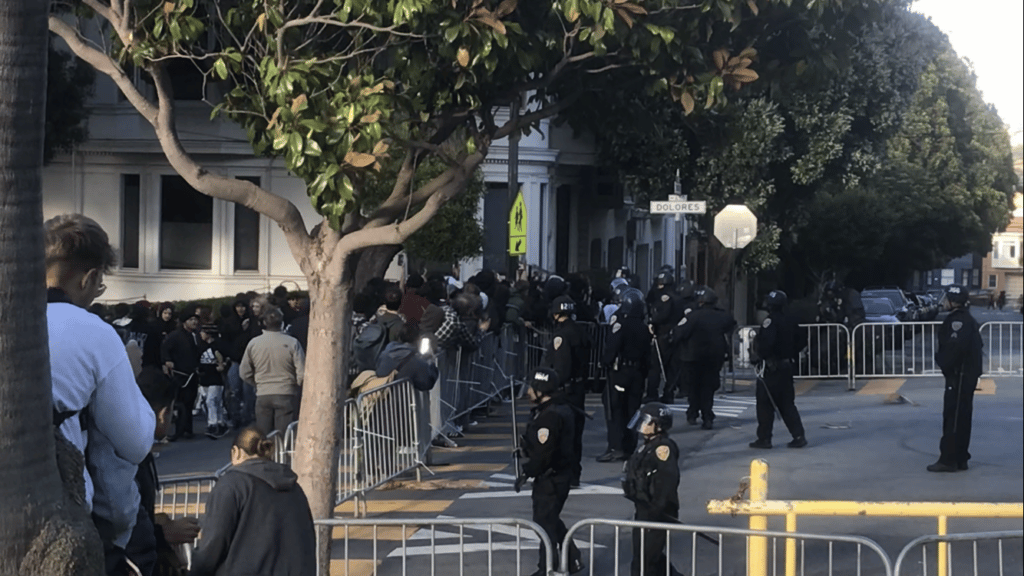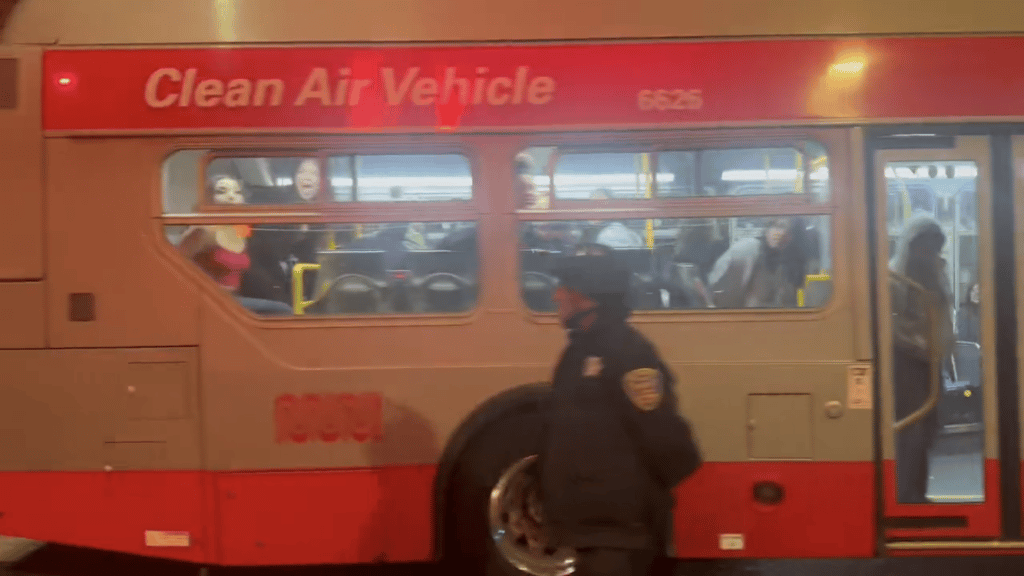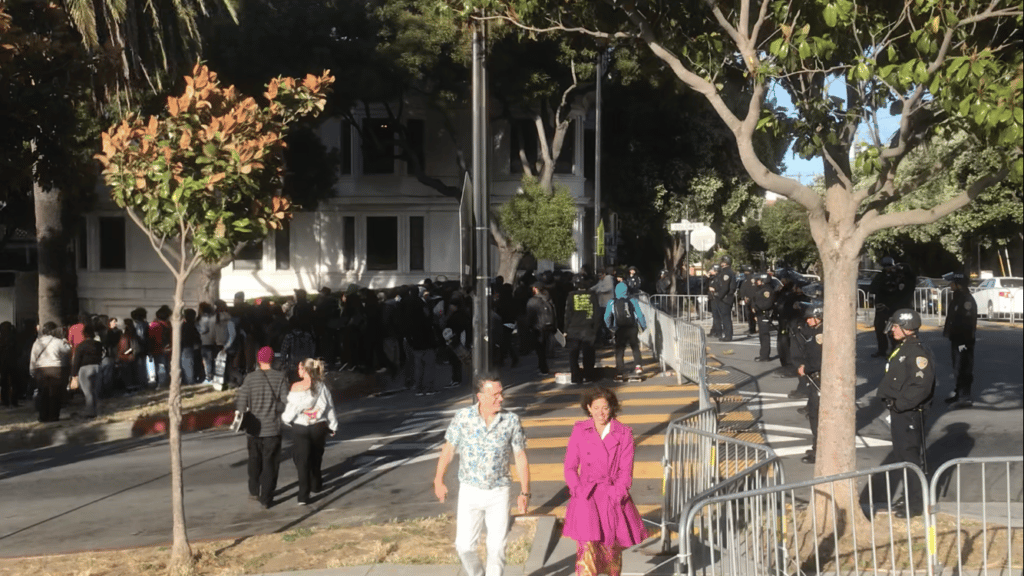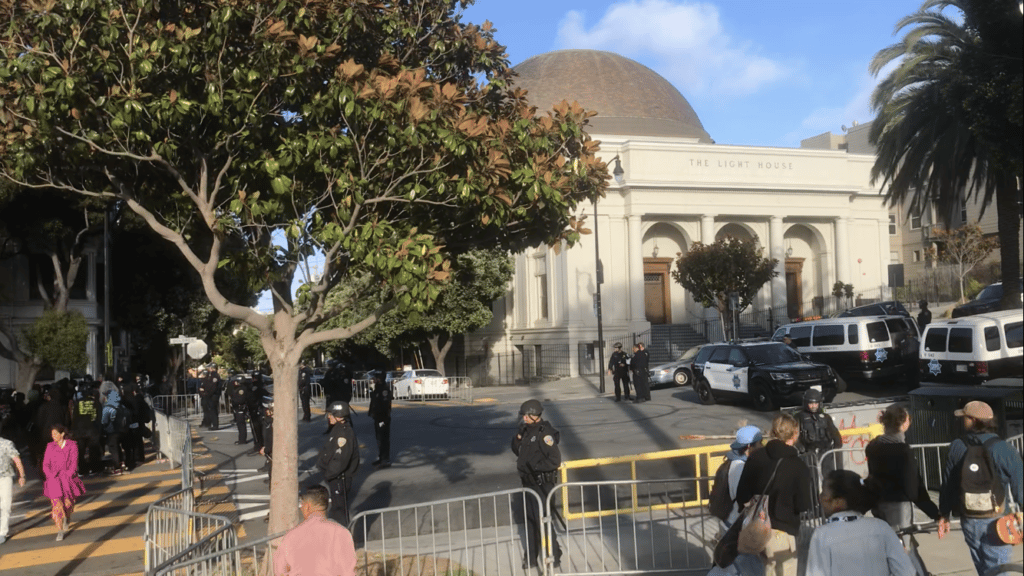
Police actions at the Dolores Hill Bomb were reckless and thoughtless. (Joe Sciarrillo)
BY JOE SCIARRILLO
Saturday’s Dolores Hill Bomb, in my experience as someone at the event, boiled down to SFPD and prominent city officials co-opting a grass-roots skater gathering. Over 60 SFPD officers, dozens in riot gear brandishing batons and guns, blocked Dolores Street in the afternoon to prevent youth from skating and biking down the hill in the evening. The SFPD occupation of the streets and intimidation tactics angered several teens as they arrived at what they expected to be an annual celebration of public space. At 6 p.m., skaters spent an hour riding down a partially opened section within the park and then a portion of the street, as riot police stood on the side. As the number of skaters grew and space on the street became tighter, I saw one youth spit across a barricade at an officer, which spiraled the two sides into clashes. The riot police pushed everyone including pedestrians out of the park and nearby streets, but left Church Street open. A riled up and traumatized crowd continued to skate and bike on Church Street while some tagged Muni buses and trains. Police returned and encircled several groups throughout the night, resulting in 113 skaters and bystanders being arrested.
Mayor Breed, Police Chief Scott, and Supervisor Mandelman condoned further use of force by militarizing the streets of the Mission District after years of critical press coverage from CNN and Fox News. This comes in the wake of Governor Newsom sending in the National Guard and CHP officers to “stem the tide” of public drug use and fentanyl overdose deaths. It comes on the heels of dozens of riot police breaking up fireworks gatherings in the streets of the Mission on the 4th of July, which included police pushing and using batons to strike several skateboarders there. San Francisco’s skaters have witnessed police brutality for decades, but these last two encounters in one week signal a dramatic shift.
Granted, the June 9 mass shooting in front of Mission Skateboards/Dying Breed shop on 24th and Treat Avenue, in which a drive-by shooting targeted a block party, has been used by city officials as a reason for more security measures. But the timeline of Saturday’s events is rarely mentioned in most news outlets’ accounts so far. Before we look at the details of Saturday, it’s important to take a minute to see the broader local skate history at play.
Local Journalism for Working stiffs
We write for the poets, busboys, and bartenders. We cover workers, not ‘tech’, not the shiny ‘forbes 100 bullshit’. We write about the business on your corner and the beer in your hand. Join the Bay's best newsletter.
I’m a 39-year-old skater, working as a street outreach social worker in the city. I’ve been skating here since I was a 9 year old in the early 90s. I’ve seen fellow skaters get handcuffed and cited by SFPD, along with their boards confiscated, just for riding their boards at the Embarcadero. I’ve had a friend get zip-tied and forced to take a mugshot by a private security guard downtown for skating in a parking lot. And as a white male who has never been arrested for skating, I’ve definitely noticed racial bias among law enforcement officers to go after skaters of color.
Still, I have been stopped and ticketed by SFPD for simply skating along the shoulder of Fillmore and Waller streets. According to the Board of Supervisors’ Legislative analyst, skateboarding has been prohibited on all city streets at all times since 2003 (I would guess possibly longer). Aside from skating in certain parks, it is only legal to skate in non-business district sidewalks around sunrise to sundown (Traffic Code, Section 100). The infamous “Skateboarding is not a crime” slogan is still a dream. And several youths who were arrested on Saturday were told by SFPD that they were arrested for skateboarding. Yes, several kids shot fireworks at police and tagged Muni trains and buses and were arrested and cited for those reasons. But the busloads of officers in riot gear, who were waiting on Dolores Street before the skaters gathered, knew that they could use that legal card at any moment.
Before other skaters gathered, I approached an officer at 5 p.m. to ask why so many officers were present. He was sitting in a parked SUV, packed with five other officers, and sternly replied, “There’s gonna be no skating here! Zero tolerance for the hill bomb!”
Saturday’s dramatic use of police enforcement was an unfortunate, shocking rebuke to the Defund the Police movement and the work of Black Lives Matter activists. The same corner of Dolores Park was a frequent location where racial justice marches occurred in the summer of 2020. Tracy McCray, President of the SF Police Officer’s Association stated, “In years past, this unpermitted event resulted in severe injuries and even death. Our officers were there to try and facilitate a safe event. However, when the participants chose violence and destruction over fun and community, our limited number of officers were taken from protecting other neighborhoods to deal with this chaos.”
This statement is a slap in the face to many skaters who were met with police who were blocking an event, rather than trying to facilitate an event. And skaters remember the 2017 Dolores hill bomb in which an SFPD officer blocked a skater’s path at the bottom of the hill, elbowed the skater, resulting in him flying into a cop car, flipping over, and breaking his ankle. This last Saturday’s event came one day after the funeral for a local, beloved skater Zion Williams who was blinded years ago from a shooting and recently died from health complications.


(Joe Sciarrillo)
Many skaters flock to the Dolores Hill bomb as a way to congregate, have fun, and share self-expression while dealing with many shared traumas in the community. Pablo ‘P-Spliff” Ramirez of the infamous GX1000 crew died of head trauma in a skating accident in 2019 in SoMa. Jake Phelps and Mark ‘Nosey’ Dillard reportedly died from fentanyl overdoses in 2019 and 2020. Tomoko Oikawa suffered a brain injury during a fall at the 2019 Dolores Hill Bomb gathering. Like the NFL’s controversial lack of transparency around CTE brain injuries, the skate community is grappling with how we handle risks and safety. Andrew Sanders, a local cyclist, died at the 2020 Dolores Hill Bomb after colliding with a skater. But simply blocking skaters from one street will not solve the ongoing issue of brain injuries nor will it ever solve rowdy crowds. In fact, we saw that this militarized strategy backfired and created more chaos.
Aiming guns at teenagers and surrounding them with military gear will only traumatize them, trigger some to shut down and freeze (not move when police try to push them out of a street) or it will push some kids to fight back with fireworks. Dialogue is needed to look at how de-escalation tactics can be much more useful in addressing crowd and safety issues at these types of gatherings. In a city that has sanctioned public gatherings after initial prohibitions (Critical Mass bike rides, Burning Man parties, Low-rider cruise nights) and has expanded events like the Bay to Breakers and Carnaval into multiple-mile long block parties, it’s time for city officials to engage with skaters in a respectful way, legalize skateboarding, and sit down with skaters to find compromises on using streets for gatherings like the Dolores Hill Bomb.

As skaters, we have an opportunity for growing solidarity with the broader progressive movements in the Bay: Black Lives Matter, LGBTQIA, immigrant rights, housing, labor, environmental, disability and safe streets groups. All of these groups are navigating law enforcement overreach in many ways and we have more reasons to link up for nonviolent protest, legislative campaigns, and for supporting everyone’s public events.
*A comprehensive accounting of the events that unfolded throughout the day and night can be found here from Joe Rivano Barros and MissionLoc@l.
Grab the Limited Edition BAS x Amos Goldbaum Shirt!

The post Longtime San Francisco Skater Cites Police for Dolores Hill Bomb Fallout appeared first on Broke-Ass Stuart's Website.









